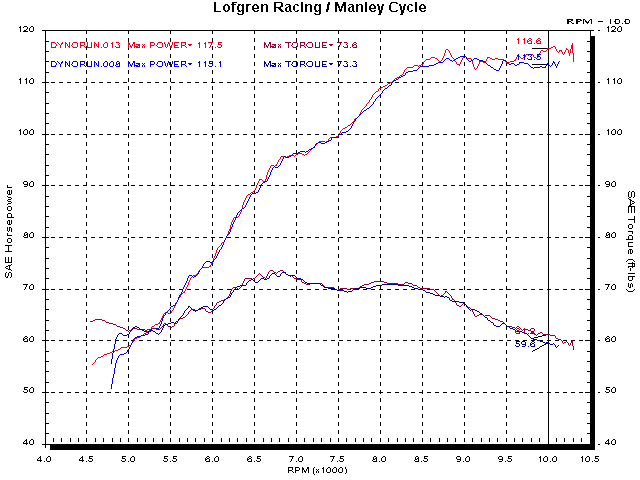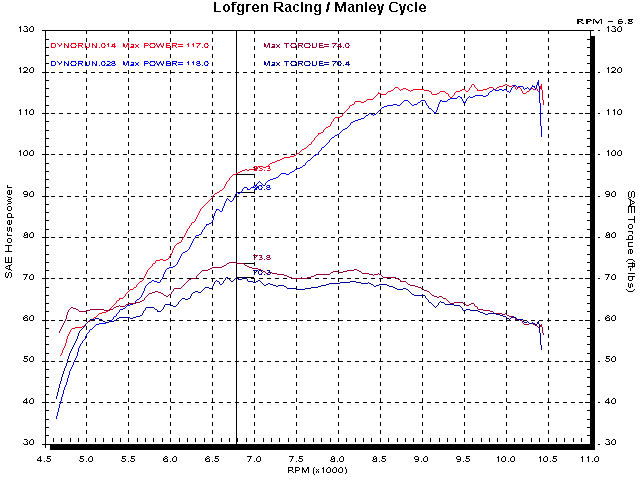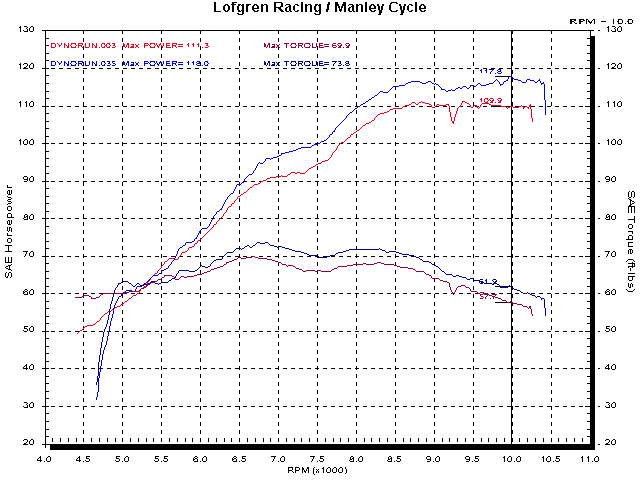
The Cam Timing Test
I've finally taken the time to test a full range of cam timing numbers from very narrow lobe centers to factory specifications (119.5-112.)
Configuration
This is a stock MY 2000 996S with an Arrow 52mm system and an ITG filter. Stock filters were removed.
Procedure
The procedure was to start at the narrowest lobe centers and open them up in nearly equal increments, starting with the inlet. An increment was chosen which was large enough to create significant change.
The air/fuel ratio was monitored and adjusted to keep it within a band that shouldn't result in a power loss. During the testing, this proved to be a significant variable. Fortunately, mapping changes are easily done.
That is the vulnerability in this particular type of testing. Anyone drawing conclusions from cam-timing alone might, actually, be feeling some effect from changing air/fuel ratio.
Conclusion
This particular example didn't respond as I had expected at the top-end of the power curve. All of the 996s I've tested have had a rather flat top to the power curve. When things (fuel and timing) are correct, this flat top extends for 1500 RPM or more. Some of the 996 Stradas have responded to larger exhaust pipes by generating a more rounded top to the power curve, this does not. Therefore, this test example probably skews the results a little by having a restriction to the effects of wider lobe-center cam timing to the top-end.
There appears to be no sacrifice in max torque from too narrow (105 - 105) to the optimum settings.
And, there is no gain in power (with this configuration) from opening lobe centers from the optimum to stock specifications. (119.5 I - 112 E)
Overall, the results are consistent with theory.
Do not assume that this applies to 748s or other 4V engines. They each have there own set of limitations/restrictions which will influence the optimum cam timing.
Opinion
At this point I have to inject an element of opinion.
There are always some people who talk about wanting torque rather than power. Torque doesn't necessarily produce any work, power is/does. You can produce torque at no RPM (torque wrench on a non-movable fastener) and produce no work. You can not produce power without torque and RPM (or some other measure of distance.)
Trying to make a 996 into a big-bore 900SS just doesn't work. The bore-stroke ratio and the overall breathing dictate that the characteristics of these two engines will never meet in the middle. Therefore, finding a good compromise of mid and high RPM power/torque best suits the characteristics of the 996.
The Test
The first chart shows a comparison of the two extremes of cam timing tested. Can you tell which is which?

The blue trace represents the narrowest lobe center and the red is the the stock timing. Clearly, the narrow lobe centers sacrifice top-end and the stock timing loses torque. The too narrow timing is about as close as you'll get to a big-bore 900SS.
Here comes the interesting part. Y'know that talk about torque over power? Well, from the narrowest lobe centers to the optimum (in this series) there appears to be no loss of torque, but an improvement in power. There is no reason to use the narrowest lobe centers. The chart below shows the narrowest from that chart above (run # 008, blue) and what turned out to be the optimum. I don't feel confident in saying that too narrow actually has less torque, (even though, in this test it does) but I would conclude that there is little-or-no compromise to opening the lobe centers to the optimum.

As stated earlier, the top-end is restricted somewhat so the potential for HP increase isn't realized. The engine is running out of air when the cam timing is trying to make the peak power.
Below is a chart showing the optimum timing and the stock timing. The torque lose is apparent while a top-end power increase isn't realized.

Part of the problem with realizing the power increases is the RPM tuning points of the pipe. There is a dip at 9200RPM and, above that, the engines breathing ability (ports and cams) is insufficient to show the potential of this end of the cam timing tests. This is much the same effect that occurs with the 900SS where the (inlet length) negative tuning point occurs just above 7000RPM and the engine doesn't breath well enough above that. Game over!
I'd think I know how to lower the tuning points, but you can't test forever y'know.
Finally, the resulting performance of pipe installation and cam timing. The bike came in with Termignoni slip-ons.
